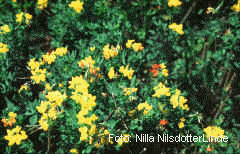Project manager: Torsten Eriksson, Department of Animal Nutrition and Management, SLU.
Starting from 2008, rations in organic dairy farming must consist of 100% organic feeds. This requirement will create a great challenge for the protein supply of high-yielding cows. Important protein crops like soybeans and sunflowers are not suitable for growing in Sweden. A key factor in organic dairy farming is successful utilization of homegrown forage. Forage from leys dominated by legumes such as red clover, white clover or lucerne already forms the basis of rations for organic dairy cows in Sweden. The nitrogen-fixing ability of legumes supports high forage yields without artificial fertilizers. Their high crude protein content should theoretically be sufficient to cover most of the cow’s protein requirement.
Certain legumes such as birdsfoot trefoil (Lotus corniculatus L.) and sainfoin (Onobrychis) contain condensed tannins, which decrease ruminal protein degradation by binding to proteins. The protein-tannin complex is dissolved when exposed to the lower pH in the abomasum and the protein may then be digested and absorbed in the small intestine. Despite the relatively low tannin content of birdsfoot trefoil grown in Sweden, previous experiments have demonstrated varietal differences in ruminal in vitro degradation of protein.
The objective of the experiment is to examine whether a ration with silage from birdsfoot trefoil grown in Sweden has the capacity to improve protein supply and nitrogen utilization in dairy cows.
- Silage from a birdsfoot trefoil-perennial ryegrass ley will be compared to silage from a white clover-perennial ryegrass ley and fed to dairy cows in early lactation.
- Milk production and nitrogen excretion from faeces and urine will be measured.
- Microbial protein production will be estimated by analyses of urinary allantoin and total purines in rumen contents.
- Nitrogenous compounds such as peptides, amino acids and ammonia will also be monitored in the rumen to define the extent of protein degradation.
These measurements will allow us to study the proportion of intake protein excreted in milk, faeces and urine and also to estimate differences in microbial protein production.
